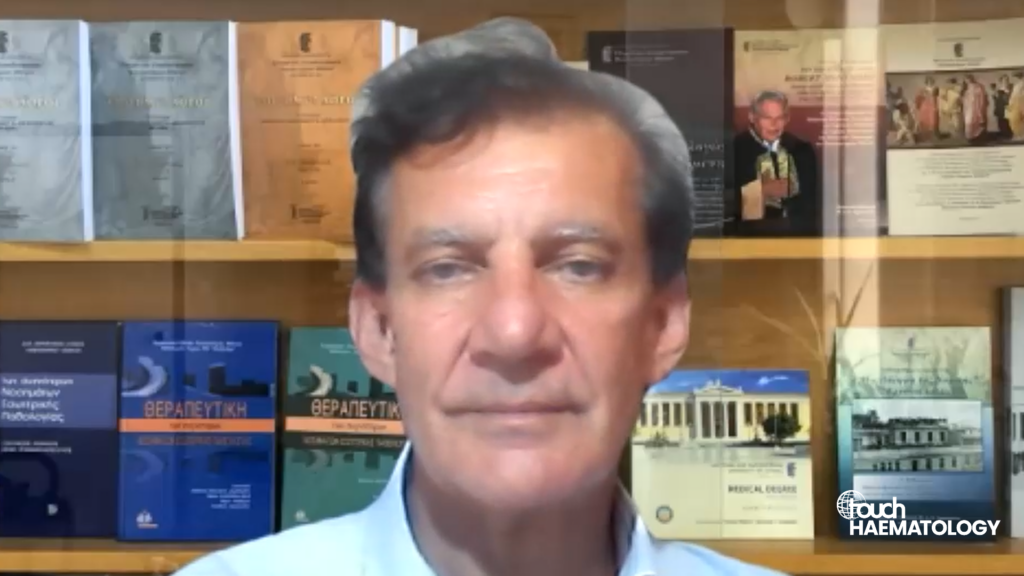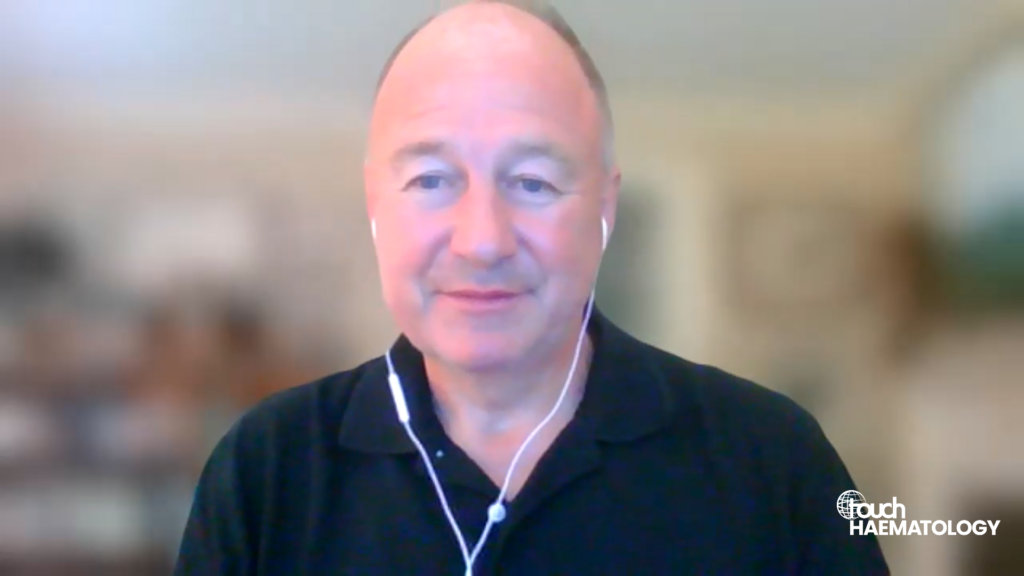The EHA 2024 congress has once again united top haematology experts from around the globe. This year’s event featured plenty of innovations and developments, from novel therapies to cutting-edge genetic studies. In this article we provide an overview of the late-breaking abstracts presented at the meeting.
 New therapy for mantle cell lymphoma shows promise in elderly patients
New therapy for mantle cell lymphoma shows promise in elderly patients
In a significant advancement for the treatment of mantle cell lymphoma (MCL), the recent phase III ECHO trial has demonstrated that a new combination therapy can significantly extend progression-free survival (PFS) in elderly patients. The trial evaluated the efficacy of combining acalabrutinib with bendamustine and rituximab (ABR) compared to a placebo with bendamustine and rituximab (PBR) in patients aged 65 and older with previously untreated MCL.
In this analysis, 598 patients were included, with 299 patients in each arm. The median age was 71 years, with 76% having low/intermediate simplified Mantle Cell Lymphoma International Prognostic Index (MIPI) and 13% having blastoid/pleiomorphic histology. Patient characteristics were balanced between arms. After a median follow-up of 45 months, 31.8% of patients in the ABR arm and 25.8% in the PBR arm continued treatment. Overall response/CR rates were 91.0%/66.6% with ABR and 88.0%/53.5% with PBR. Median PFS was 66.4 months for ABR and 49.6 months for PBR (HR 0.73; 95% CI 0.57, 0.94; P=0.0160). Overall survival (OS) showed a positive trend favouring ABR (HR 0.86; 95% CI 0.65, 1.13; P=0.27) despite 51 patients crossing over to acalabrutinib after disease progression with PBR. The trial’s results were notably impacted by the COVID-19 pandemic, which affected patient outcomes due to related complications and deaths.
The ECHO trial indicates that adding acalabrutinib to bendamustine and rituximab is a promising first-line treatment for elderly mantle cell lymphoma patients.
New treatment combination shows promising results for relapsed multiple myeloma patients in DREAMM-8 trial
In a recent study, the DREAMM-8 clinical trial has shown promising results for a new treatment combination for patients with relapsed/refractory multiple myeloma (RRMM). This study evaluated the efficacy and safety of belantamab mafodotin combined with pomalidomide and dexamethasone (BPd) against the standard care regimen of pomalidomide, bortezomib and dexamethasone (PVd) in patients who had previously been treated with lenalidomide.
The trial involved 302 patients, who were randomized in a 1:1 ratio to receive either BPd or PVd. Results revealed that BPd significantly improved the median progression-free survival (PFS), which was not reached but estimated to exceed 20.6 months. In contrast, the median PFS for patients on PVd was 12.7 months. This difference was statistically significant, with a hazard ratio (HR) of 0.52 and a p-value of less than 0.001.
Furthermore, the objective response rate for the BPd treatment was 77%, compared to 72% for PVd. BPd achieved a higher rate of complete response or better, at 40% versus 16% for PVd. The median duration of response also favoured BPd, with a duration not reached but estimated to be over 24.9 months, compared to 17.5 months for PVd.
The BPd arm reported a higher incidence of ocular adverse events (89% versus 30%) and serious adverse events (63% versus 45%). However, the study noted that these adverse events were consistent with the known safety profiles of the individual agents.
These findings indicate that BPd could be an effective therapeutic option for managing RRMM, especially in cases refractory to lenalidomide.
Elevated haemoglobin in Andean Aymaras linked to alternative splicing of NFKB1
A groundbreaking study has unveiled the genetic basis for the elevated hemoglobin (Hb) levels observed in the Andean Aymara population. The unique genetic adaptation involves alternatively spliced transcripts of the NFKB1 gene, contributing to the population’s ability to thrive at high altitudes. Unlike Tibetans and Ethiopians, who maintain sea-level Hb levels, Aymaras exhibit significantly higher Hb levels.
The research team conducted a transcriptome analysis on Aymara and European samples collected in La Paz, Bolivia, situated at approximately 4,000 metres above sea level. They identified 2,601 differentially expressed genes and 1,922 spliced genes in Aymara associated with immune, inflammatory and hypoxia-related pathways. A critical discovery was the alternatively spliced transcripts of the NFKB1 gene (AS-NFKB1), a key component of the NF-κB pathway.
These AS-NFKB1 transcripts correlated with increased inflammation and elevated Hb levels, driven by upregulation of HIF-regulated genes. The study also identified a significant single nucleotide polymorphism (SNP), rs230511, highly selected in the Aymara population and linked to their unique adaptation.
This research marks the first identification of a genetic signature explaining the elevated Hb levels in Aymara, shedding light on the evolutionary benefits of their increased inflammatory response. The findings underscore the complex interplay between genetic adaptations and environmental challenges in shaping human physiology.
Vitamin C supplementation shows promise in extending survival in patients with low-risk myeloid malignancies
A recent study has shown that vitamin C supplementation can significantly improve survival outcomes in patients with low-risk myeloid malignancies and clonal cytopenia of undetermined significance (CCUS). The EVI-2 study, a randomized, placebo-controlled phase II trial, investigated the safety and efficacy of oral vitamin C (1,000 mg/day) over a 12-month period. This study included 109 patients across four centres in Denmark and the USA. Participants were divided into two groups: 55 received vitamin C, and 54 received a placebo.
At baseline 57% of the patients were vitamin C deficient. By the end of the study, those in the vitamin C group saw a significant increase in median plasma vitamin C levels, from 45.85 μmol/L to 81.90 μmol/L, unlike the placebo group, which saw no significant change. The study reported 31 serious adverse events (SAEs) in the vitamin C group, compared to 57 in the placebo group, indicating a better safety profile for those on vitamin C. Over a median follow-up of 33.5 months, the vitamin C group experienced significantly fewer deaths (11) compared to the placebo group (24). Median overall survival was not reached in the vitamin C group, whereas it was 42.2 months for the placebo group, suggesting a potential survival benefit for those on vitamin C (HR 2.88; P=0.0025).
The findings indicate that vitamin C supplementation could be a beneficial therapeutic strategy for patients with low-risk myeloid malignancies, potentially improving overall survival. The significant increase in vitamin C levels and reduced incidence of serious adverse events support its safety and efficacy. The study’s promising results highlight the need for a larger phase III trial to confirm these findings and further explore the benefits of vitamin C in this patient population.
New antibody treatment shows promise for deadly inflammatory condition in early trial
In a recent phase I study, the novel monoclonal antibody ELA026 has shown promising results in treating secondary hemophagocytic lymphohistiocytosis (sHLH), a severe hyperinflammatory condition. This condition, particularly when associated with malignancies (mHLH), has a high mortality rate of around 50% within two months. Traditional cytotoxic chemotherapy has proven insufficient for improving the prognosis of mHLH.
The study, presented in an oral session, aims to evaluate the safety and efficacy of ELA026, which targets SIRP(+) immune cells. Conducted globally, the open-label, single-arm phase Ib trial included adult and paediatric patients, both newly diagnosed and previously treated with sHLH.
The trial was divided into three cohorts. Cohort 1 involved intra-patient dose escalation of ELA026, while Cohort 2 used a fixed dose regimen with a priming and maintenance phase. Cohort 3, still ongoing, employs a similar regimen but with more frequent dosing. All participants received background therapy with dexamethasone, and those with mHLH could receive concurrent cancer therapies.
Results from Cohorts 1 and 2, which included 12 patients, showed a 75% response rate by Week 4, with one modified complete response and eight partial responses. Treatment-naïve patients demonstrated a median survival of about five months, compared to less than one month for relapsed or refractory patients. This led to focusing Cohort 3 enrollment on treatment-naïve patients.
As of April 17, 2024, five patients were enrolled in Cohort 3, with a median age of 32 years. Four had malignancy-triggered HLH, and one had acute EBV infection. Among the eight treatment-naïve mHLH patients, the response rate was 100% by Week 4, with one complete response and seven partial responses. All patients survived beyond two months, although the median survival has not yet been reached.
The study also reported manageable treatment-related side effects, including infusion reactions and cytopenias, which were addressed with supportive care and dosing adjustments. Infection risks were mitigated with growth factor support and antimicrobial prophylaxis.
Preliminary data indicate that ELA026 is well-tolerated and significantly improves the two-month survival rate in treatment-naïve mHLH patients. The study continues to assess the efficacy of ELA026 in this patient population, which currently lacks effective or approved therapies.
New study unveils proteome dynamics in haematopoietic stem cells
A groundbreaking study presented at the latest conference highlights the intricacies of hematopoietic stem cell (HSC) behaviour, particularly in normal and malignant contexts. Researchers focused on the role of TET2 mutations, commonly found in myeloproliferative neoplasms (MPNs), which enhance the self-renewal capability of HSCs, leading to clonal outgrowth.
The study utilized advanced proteomic profiling techniques to analyze both the cellular and extracellular environments of HSCs. The findings revealed significant differences in protein expression between normal and TET2-deficient HSCs, identifying novel molecular components missed by previous transcriptomic analyses.
Key discoveries include the altered expression of extracellular matrix proteins in Tet2-deficient HSCs, contributing to a pro-inflammatory and pro-thrombotic microenvironment even in asymptomatic animals. Additionally, successful HSC expansion in vitro was linked to intact DNA repair pathways, with enzymes like Parp1 and Fto playing crucial roles.
The research opens new avenues for HSC expansion and leukaemia treatment by highlighting the importance of the proteome in understanding and manipulating HSC function and their microenvironment.
Following this year’s meeting, EHA released the EHA2024 Scientific Congress Report titled “EHA Perspectives on Emerging Technologies in Hematology.” This pilot initiative aims to offer a concise overview of the innovative work presented at EHA2024 and will serve as a model for future EHA congresses.
Disclosures: This article was created by the touchHAEMATOLOGY team utilizing AI as an editorial tool (ChatGPT (GPT-4o) [Large language model]. https://chat.openai.com/chat.) The content was developed and edited by human editors. No funding was received in the publication of this article.






